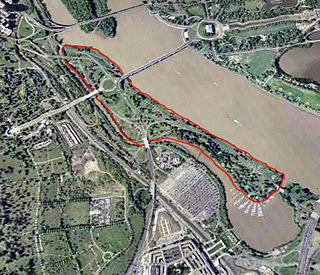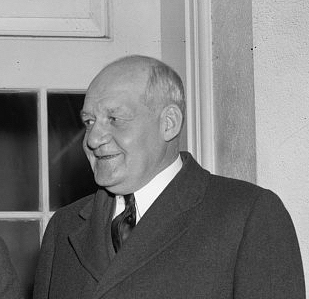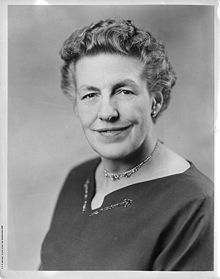
The United States Social Security Administration (SSA) is an independent agency of the U.S. federal government that administers Social Security, a social insurance program consisting of retirement, disability and survivor benefits. To qualify for most of these benefits, most workers pay Social Security taxes on their earnings; the claimant's benefits are based on the wage earner's contributions. Otherwise benefits such as Supplemental Security Income (SSI) are given based on need.

Federal Triangle is a triangular area in Washington, D.C., formed by 15th Street NW, Constitution Avenue NW, Pennsylvania Avenue NW, and E Street NW. Federal Triangle is occupied by 10 large city and federal office buildings, all of which are part of the Pennsylvania Avenue National Historic Site. Seven of the buildings in Federal Triangle were built by the U.S. federal government in the early and mid-1930s as part of a coordinated construction plan that has been called "one of the greatest building projects ever undertaken" and all seven buildings are now designated as architecturally historic.

The U.S. Railroad Retirement Board (RRB) is an independent agency in the executive branch of the United States government created in 1935 to administer a social insurance program providing retirement benefits to the country's railroad workers.

The United States Bullion Depository, often known as Fort Knox, is a fortified vault building located next to the United States Army post of Fort Knox, Kentucky. It is operated by the United States Department of the Treasury. The vault is used to store a large portion of the United States' gold reserves as well as other precious items belonging to or in custody of the federal government. It currently holds roughly 147 million troy ounces of gold bullion, a little over half the total gold presently held by the federal government. The United States Mint Police protects the depository.

Lady Bird Johnson Park, formerly known as Columbia Island until 1968, is an island located in the Potomac River in Washington, D.C., in the United States. It formed naturally as an extension of Analostan Island in the latter part of the 1800s, and over time erosion and flooding severed it from Analostan, now known as Theodore Roosevelt Island.

The John Philip Sousa Bridge, also known as the Sousa Bridge and the Pennsylvania Avenue Bridge, is a continuous steel plate girder bridge that carries Pennsylvania Avenue SE across the Anacostia River in Washington, D.C., in the United States. The bridge is named for famous United States Marine Band conductor and composer John Philip Sousa, who grew up near the bridge's northwestern terminus.

The Federal Shipbuilding and Drydock Company was a United States shipyard in New Jersey active from 1917 to 1948. It was founded during World War I to build ships for the United States Shipping Board. Unlike many shipyards, it remained active during the shipbuilding slump of the 1920s and early 1930s that followed the World War I boom years. During World War II, it built merchant ships as part of the U.S. Government's Emergency Shipbuilding program, at the same time producing more destroyers for the United States Navy than any yard other than the Bath Iron Works. Operated by a subsidiary of the United States Steel Corporation, the shipyard was located at Kearny Point where the mouth of the Hackensack River meets Newark Bay in the Port of New York and New Jersey.

The Constitution Center, formerly known as the David Nassif Building, is an office building located at 400 7th Street SW in Washington, D.C. It is 140 feet (43 m) high and has 10 floors. Covering an entire city block, it is the largest privately owned office building in Washington, D.C. Current tenants include the Federal Housing Finance Agency and the Office of the Comptroller of the Currency. As of February 2014, Constitution Center was worth $725.8 million, making it the most valuable taxable property in the city.

Washington-Hoover Airport was an airport serving the city of Washington, D.C., in the United States from 1933 to 1941. It was created by the merger of Hoover Field and Washington Airport on August 2, 1933. It was in Arlington, Virginia, near the intersection of the Highway Bridge and the Mount Vernon Memorial Highway. Washington-Hoover Airport, like its predecessors, suffered from safety problems, short runways, and little room to grow. It closed for public use in June 1941, and the United States Department of War purchased the site in September, closing it for good. Washington National Airport, which opened in June 1941, was built as its replacement. The Pentagon now occupies the site.

The Pentagon is the headquarters building of the United States Department of Defense, in Arlington County, Virginia, across the Potomac River from Washington, D.C. The building was constructed on an accelerated schedule during World War II. As a symbol of the U.S. military, the phrase The Pentagon is often used as a metonym for the Department of Defense and its leadership.

James Alfonso Wetmore was an American lawyer and administrator, best known as the Acting Supervising Architect of the U.S. Office of the Supervising Architect of the Treasury Department from 1915 through 1933.

The District of Columbia Department of Parks and Recreation (DPR) is an executive branch agency of the government of the District of Columbia in the United States. The department plans, builds, and maintains publicly owned recreational facilities in District of Columbia, including athletic fields, community centers, parks, playgrounds, swimming pools, spray pools and tennis courts. It also manages publicly run recreational sports leagues for youth and adults as well as provides various outdoor activities for youth, adults, and senior citizens.
William Louis Ayres, better known by his professional name Louis Ayres, was an American architect who was one of the most prominent designers of monuments, memorials, and buildings in the nation in the early part of the 20th century. His style is characterized as Medievalist, often emphasizing elements of Romanesque Revival and Italian Renaissance, and Byzantine Revival architecture. He is best known for designing the United States Memorial Chapel at the Meuse-Argonne American Cemetery and Memorial and the Herbert C. Hoover U.S. Department of Commerce Building.

Harry Alvin Millis was an American civil servant, economist, and educator and who was prominent in the first four decades of the 20th century. He was a prominent educator, and his writings on labor relations were described at his death by several prominent economists as "landmarks". Millis is best known for serving on the "first" National Labor Relations Board, an executive-branch agency which had no statutory authority. He was also the second chairman of the "second" National Labor Relations Board, where he initiated a number of procedural improvements and helped stabilize the Board's enforcement of American labor law.

The Wilbur J. Cohen Federal Building is a historic building at 330 Independence Avenue, Southwest, Washington, D.C., United States.

The James V. Forrestal Building is a low-rise Brutalist office building in Washington, D.C. Originally known as Federal Office Building 5, and nicknamed the Little Pentagon, the Forrestal Building was constructed between 1965 and 1969 to accommodate United States armed forces personnel. It is named after James Forrestal, the first United States Secretary of Defense. It became the headquarters of the United States Department of Energy after that agency's creation in 1977.

John Raymond McCarl was an American lawyer and executive secretary of the national Republican Congressional Campaign Committee. He was the first Comptroller General of the United States, serving from 1921 to 1936. During his time in office, he was one of the most powerful and controversial officials in the U.S. federal government.
The construction of the Virginia approaches to Arlington Memorial Bridge was a 16-year road construction project to connect Arlington Memorial Bridge with roads in Arlington County, Virginia, in the United States. Initial design proposals were made in 1926, but extensive political wrangling and indecision delayed the project and even the new bridge itself, which finally opened in 1932 after a connection to the Arlington National Cemetery was made via Memorial Drive.
The National War Labor Board, commonly the War Labor Board, was an independent agency of the United States government, established January 12, 1942, by an executive order of President Franklin D. Roosevelt, the purpose of which was to mediate labor disputes as part of the American home front during World War II.
Alfred David Bernstein was an American civil rights and union activist.




















